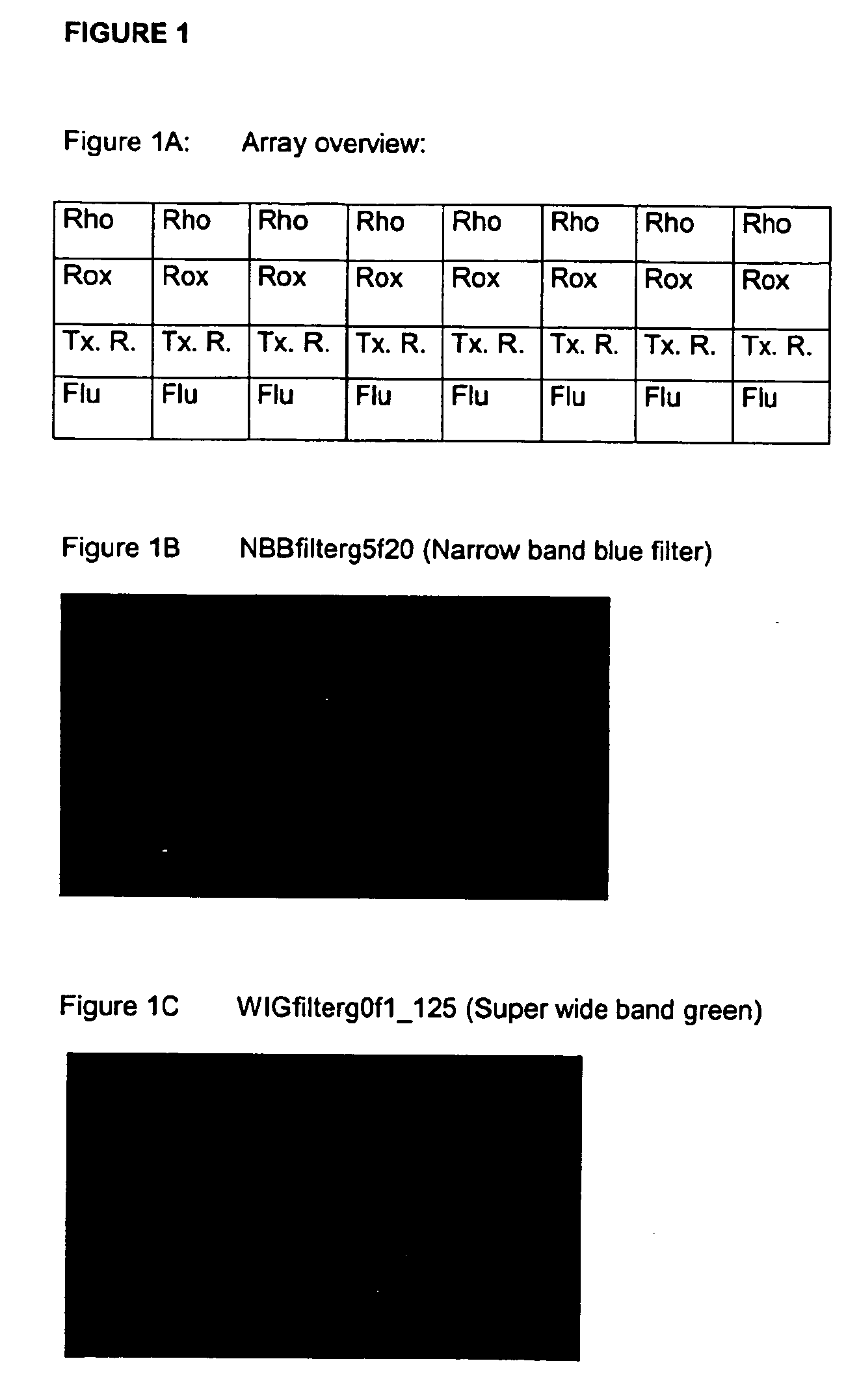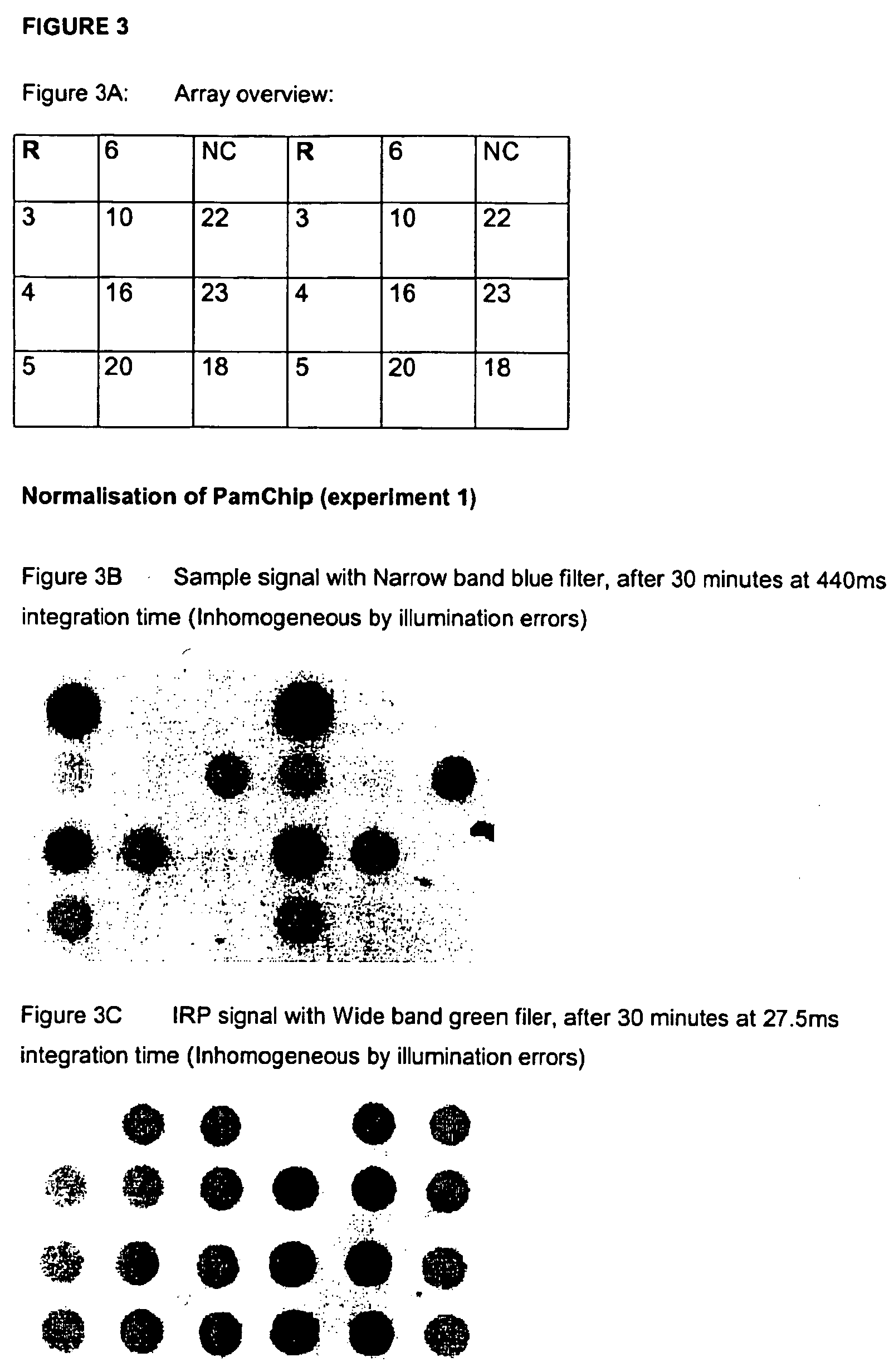Normalisation of microarray data based on hybridisation with an internal reference
a microarray and internal reference technology, applied in biochemistry apparatus, informatics, biochemistry apparatus and processes, etc., can solve the problems of spot to spot variation, limited efficiency of target nucleic acid hybridization to the array, and differences in the intensity of hybridization to different probe nucleic acids of the array, etc., to achieve better detection of nucleic acids, increase stringency, and high throughput
- Summary
- Abstract
- Description
- Claims
- Application Information
AI Technical Summary
Benefits of technology
Problems solved by technology
Method used
Image
Examples
example 1
Materials
[0177] Detections were performed utilising fluorescent microscopy (Olympus, Tokyo Japan).
[0178] Oligonucleotides were prepared and coupled to the substrate as previously described in PCT / EP98 / 04938. A non-human plant virus sequence from the Potato Leafroll RNA Virus (PLRV)-S2 sequence was used as internal reference IRP; (see Klerks et al. J. Vir. Methods 93 (2001)115-125).
[0179] Oligonucleotide sequences: [0180] IRP: PLRV-s2 (SEQ ID NO: 1; tgcaaagtatcatccctccag) (5′ activated) [0181] Rho: Reporter probe, 5′-Rhodamine labelled comPLRV_rho (SEQ ID NO: 2; ctggagggatgatactttgca) [0182] Rox: Reporter probe 5′-ROX labelled comPLRV_rox (SEQ ID NO: 3; ctggagggatgatactttgca) [0183] TxR: Reporter probe 5′-Texas Red labelled comPLRV_tex (SEQ ID NO: 4; ctggagggatgatactttgca); [0184] F2: Target sequence 5′-fluorescein labelled F2, (SEQ ID NO: 5; TCC TTT TCC AGT TCT GTA CAA) [0185] R REF1(S2+F), (5′-FAM labelled) designated as R (SEQ ID NO: 6; catgtatcgaggataaatgaag) [0186] HIVpol7p41...
example 2
Fluorophore for the Reporter Probe
[0187] In order to simultaneously distinguish reporter binding to the internal reference (IRP) and analyte binding to receptor, respectively, reporter and analyte should be differentially labeled. Below an experiment is given with PamGene microarray spots of 300 pL of Rhodamine (Rho), ROX (Rox) and Texas Red (Tx) labelled oligonucleotides (each 10 μM) and Fluorescein labelled oligonucleotide (F2) of 1 μM.
[0188] The experimental set up was essentially as described in WO 99 / 02266, which is herein specifically incorporated by reference.
[0189] In short, oligonucleotide probes were covalently coupled to the Anopore membranes using 3-aminopropyl triethoxysilane (APS) as a linker between the alumina and the oligonucleotide.
[0190] After rinsing with water, the membranes were dried and immersed in a 0.25% (v / v) solution of APS in water for 2 hours. Excess APS was removed by rinsing with water. After drying at 120° C. at reduced pressure the membranes wer...
example 3
IRP / Receptor Ratio Optimisation
[0195] The IRP (PLRV-s2; SEQ ID NO: 1) was mixed in different concentrations with the subject receptor (HIVpol7p41-4; SEQ ID NOs: 8), according to Table 1. The mixtures were subsequently covalently coupled as outlined in Example 2.
[0196] Different ratio's of the IRP and receptor were spotted in three-fold within one array, as depicted in FIG. 2A. Next, the microrarray was hybridised with a mixture of Tx.R. and the fluoresceine labeled HIV oligo F2, i.e. 20 μl of 1 nM reference probe comPLRV-Texas red (Tx.R.; analyte) and 20 μl of 1 nM reference probe HIV-oligo F2 (reporter) in 0.6×SSPE at 45° C. for 30 minutes at 2 pumping steps per minute with subsequent washing step with 0.6×SSPE at 45° C. The Fluoresceine-signal (by F2) was determined with a Narrow band blue filter (FIG. 2B), while the Texas red signal (by Tx.R.) was determined with a Wide band green filter (FIG. 2C).
TABLE 1Different ratio's between receptor HIVpol7p41-4 and IRP PLRV-s2.SampleIR...
PUM
| Property | Measurement | Unit |
|---|---|---|
| integration time | aaaaa | aaaaa |
| integration time | aaaaa | aaaaa |
| integration time | aaaaa | aaaaa |
Abstract
Description
Claims
Application Information
 Login to View More
Login to View More - R&D
- Intellectual Property
- Life Sciences
- Materials
- Tech Scout
- Unparalleled Data Quality
- Higher Quality Content
- 60% Fewer Hallucinations
Browse by: Latest US Patents, China's latest patents, Technical Efficacy Thesaurus, Application Domain, Technology Topic, Popular Technical Reports.
© 2025 PatSnap. All rights reserved.Legal|Privacy policy|Modern Slavery Act Transparency Statement|Sitemap|About US| Contact US: help@patsnap.com



